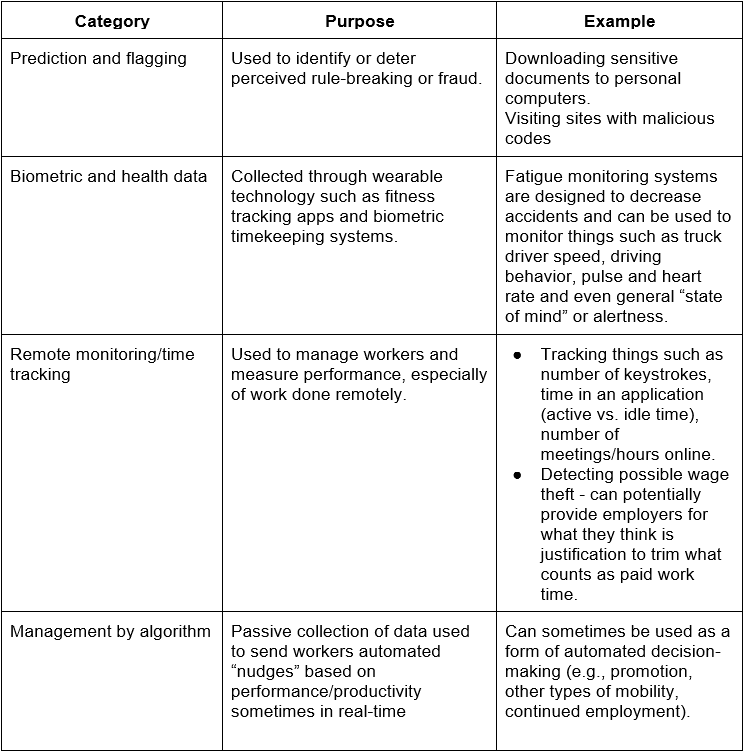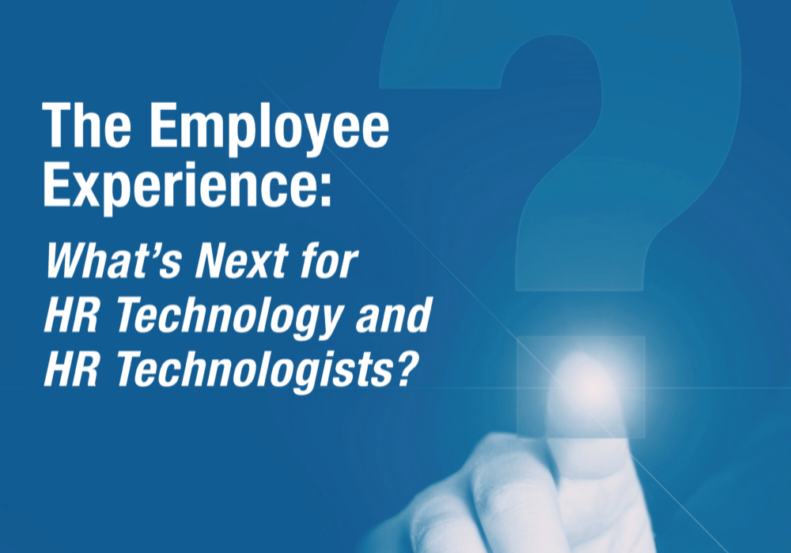As companies have been feverishly trying to mobilize to address the challenges they face in response to COVID-19, new ways of working and defining worker expectations are top of mind. In the initial stages of reacting to COVID-19 many IT leaders scrambled to secure computers for their workers, provide remote access that could support increased network traffic, and make sure that employees had tools such as collaboration software and videoconferencing solutions.
For many of these employers, having a substantial remote workforce is something new and with it comes concerns over how and whether employee productivity and business performance will be impacted. Many are turning to technology to both monitor and measure employees1. This move can have detrimental consequences to trust and will ultimately tear at the fabric of social capital which is the true lifeblood of any organization.
The use of employee monitoring software (EMS) can have a dramatic impact on employee trust and engagement and also negatively impact productivity. Given the fragile state of the workplace, managing EX is more important now than it ever was before.
What is EMS?
Employee monitoring software is a broad category that I have defined which includes tools and technology which monitors and/or tracks employees’ computer activities and behaviors in the workplace. These tools fall into roughly four categories2:

MONITORING YOUR EMPLOYEES CAN BREAK EMPLOYEE EXPERIENCE
According to Forrester Research, there are three factors that drive engagement and lead to better EX: empowerment, inspiration and enablement3. Part of enabling employees means they have the right tools and resources to do their jobs. This means having access to technology that supports their ability to work on things that matter and that does not impede their ability to be productive and perform at their best. That’s where the risk lies – many of the very same tools that should foster engagement, also generate data that can be used to monitor employees. The incautious use of such employee monitoring tools can erode employee trust, increase workplace stress, and result in negative consequences for organizations.
-
- Privacy issues aside, the use of employee monitoring software is creepy. Using software to figure out how hard employees are working, especially in the times we are in can leave employees feeling ‘icky’. Not only can it be demeaning but use of the software can leave employees feeling as if they are not trusted. In its warehouses, Amazon uses robots and sensors to monitor workers. They track and analyze the workers’ movements including time it takes to perform certain tasks and serve up real-time insights to the worker on their performance. This data then informs termination decisions. While Amazon has said they have seen improvements in efficiency and productivity, the workers feel as if they can’t be trusted and are, “treated like robots in effect because they’re monitored and supervised by these automated systems”4.
- Knowing you are being monitored increases employee stress and decreases job satisfaction. Stress levels are on the rise. Factors that contribute to workplace stress include workload, lack of perceived control over how work gets done, and fear. In an early study on the effects of EMS researchers found that, monitored employees reported higher workload, less workload variation, and also reported less control over their jobs5. Additionally, in another study, those who had a negative view of EMS were less satisfied with their jobs and experienced less autonomy6. At Barclay’s it was reported that some employees were, “worried to step away from their desks, have full lunch breaks, take bathroom breaks, or even get up for water”7. When used improperly they can create punitive work environments that place pressures on workers to meet demanding & shifting efficiency benchmarks.
- You will reinforce the wrong behavior. When employees know that they are being monitored – and they should be told – employers may see increases in workplace deviance behaviors (WDB) while also seeing reductions of organizational-citizenship behaviors (OCB). WDBs is voluntary behavior deliberately intended to cause harm in the workplace and in doing so threatens the well-being of the organization. Cheating is an example of a WDB. Employees who know that they are being watched will likely game the system. For example, call-center agents may take a call and then immediately hang up on a customer just to drive down their average handle time. Alternatively, employees may stop exhibiting extra-role behaviors and building connections with one another for fear their actions might not be seen as contributing to their “productive time”8.
TIME IS NO LONGER AN EFFECTIVE MEASURE OF PRODUCTIVITY OR COLLABORATION
Yes, use of these technologies can adversely impact EX and wreak havoc with organizational culture, but the primary problem is that most of the vendors out there are not actually monitoring or measuring productivity. This should lead you to ask: Why risk a hit to EX when the tool you’re paying for doesn’t even work? Many vendors claim they can show the ROI of monitoring through improvements in productivity. However, they do so by claiming that use of the software decreases the number of hours employees are spending surfing the web or completing personal tasks. Productivity is primarily being measured in terms of time spent, while collaboration is being measured by the number of meetings attended or emails sent. These tools do not account for the importance of the qualitative nature of collaboration and use a very narrow view of productivity which solely focuses on quantity: number of products made or sold, hours spent, or services performed. That is the wrong path. Avoid it by keeping in mind that:
- Not all collaboration is good collaboration. Software that measures collaboration by merely looking at the quantity and/or duration of meeting habits, volume of email and/or chat exchanges is simply not telling the whole story, and in some cases may be telling the wrong story. Without proper context we do not know whether two people who are meeting frequently are truly collaborating. Maybe two employees meet regularly because they are not effectively working together and must keep rehashing things. Or perhaps they have a strong social relationship.
- Quality of the interactions is the missing measurement element – yet, vendors are surfacing quantitative metrics such as amount of time spent in meetings, chatting over IM/talking on the phone or sending emails. or chat conversations and on phone calls. While some highlight this data to help employees and managers see how much focus time they are dedicating to their work each week, the message that the software can send to employees is that more collaboration is good and is an objective way to show my employer I am not slacking off. But in fact, there is such a thing as too much collaboration and research has shown that this can not only reduce productivity but lead to burnout, lower levels of engagement, and higher levels of voluntary turnover.
- To properly measure productivity, quality matters. Woody Allen supposedly once said that, “80% of life is just showing up”. Well then, if that is true then the other 50% is quality. Many vendors will have you believe that productivity means being online, focused and present throughout the workday. How you measure productivity will be contextual for every organization. It is the quality of the interactions that matter more. Paying people based on the number of widgets they produce does not make sense in a knowledge economy. Even so, a toy factory worker might be required to produce 100 toys each day. But if they do so, yet most of those toys are defective and unsellable, can you really say they were productive? Showing up is important but showing up to play the game is what matters more.
- Many drivers of productivity are outside an employee’s control. Data that is generated by EMS does not account for other potential factors that drive productivity, many of which are not in the control of the employee. Levels of productivity can be influenced by things such as the working environment, supervisor support, and HR policies and practices meant to motivate employee performance. To distill down a worker’s efforts to a single “productivity score” based solely on the amount of time spent is irresponsible.
Recommendations
MONITORING CAN WORK — ALL THAT DOES NOT GLITTER MIGHT STILL BE GOLD
As remote working becomes a more permanent part of how work gets done, employees are finding themselves attending more meetings than ever before. The Forrester research report, “Employee Experience Bill of Rights”, advocates for each employee’s right to be able to focus on their most important work and shut out distractions such as email, chat and even meetings9. Analysis of employee data through tools like Microsoft’s Workforce Analytics or Worklytics can help make this happen. The functionality in their software can surface insights for managers and employees to allow them to take more control of their time.
It is the misuse of the monitoring tools and the data they generate that I’m railing against here. When used for supportive rather than punitive purposes, EMS can benefit your employees and managers by giving them insight into their work behaviors. So if you are thinking about adding EMS software to your HR Tech stack here are a few helpful tips:
- Before buying EMS, ask to look under the hood. Ask vendors to provide details on how they count time, define collaboration and measure productivity. Ask them for proof that what they are measuring is related to productivity. For example, ActivTrak provides multiple use cases for its software, including “productivity monitoring,” but when you look under the hood at what data they are surfacing they are primarily tracking what workplace tools employees are using and what websites they are visiting. This approach is problematic in two ways. First, it assumes that the tools the company has provided are useful and relevant to ALL employees. Second, it assumes that visiting certain sites can contribute to or impede productivity. The only problem is managers and administrators can individually categorize time spent as productive, unproductive or passive, which adds a layer of subjectivity with no evidence to support the relationship to productivity.
● Use EMS for supportive, rather than punitive purposes. When used as a development tool and not a performance measurement tool, some employee monitoring software can provide valuable feedback not only to employees but also to managers. Cassiopeia, a tool meant originally to identify teams at risk of sexual harassment, bullying, and discrimination, analyzes communication patterns to help provide actionable insights to remote managers on team dynamics. Managers receive insights about their team such as how frequently they are communicating or collaborating with each team member but are also served up relevant tips and nudges on areas they can focus on to help improve interactions with their team. In this way the monitoring software is being used as a development tool. Employees don’t get assigned a productivity score nor have they designed it to be used as a mechanism to evaluate employee performance. Most importantly, they analyze the team’s communication patterns, not content, and show insights on a team/subgroup level, not for individuals – another important thing when it comes to ensuring the focus is on workplace dynamics and not individual employee behavior.
PRIORITIZE AN EMPLOYEE-CENTRIC APPROACH
All this being said there are still other valid use cases for this software especially when it comes to helping mitigate the risk of insider threats, malicious activity and the protection of corporate data. However, organizations must strike a balance that considers the impact the use of the software will have on their employees. You can mitigate the potential negative effect that EMS might have on EX by:
- Telling employees how and why they are being monitored. Disclose to employees any monitoring you’re conducting. What companies MIGHT gain in productivity might be lost in engagement and trust, especially if the business isn’t transparent about how they are monitoring workers. Despite what some vendors will tell you, even if employees know that they are being monitored that does not mean they aren’t concerned about their privacy. It is imperative that your company be transparent and not only let employees know they are being monitored but also clearly explain to them what the data will be used for and who will have access to it. Better yet, deliver reports to them that help them identify ways they can choose to improve their own performance at their own initiative – and reward them when they do.
- Surfacing data at the aggregate level for managers and leaders. This is especially important if you are planning on using the software as a developmental tool to help employees understand where they are spending their time and how they can become more efficient and less overwhelmed. This means even if you use a vendor that produces a singular “productivity score” for each employee you should seriously consider hiding that from managers; there is a good argument for not even sharing that with employees. Most importantly, never publish or make visible the individual scores of employees with others on their team. Nothing can be more demotivating in the workplace than when you are being arbitrarily compared to others, and especially when that comparison is made on imperfect measures of productivity.
Endnotes
1. Jessica Golden & Eric Chemi, “Worker monitoring tools see surging growth as companies adjust to stay-at-home orders,” CNBC, May 15, 2020 (https://www.cnbc.com/2020/05/13/employee-monitoring-tools-see-uptick-as-more-people-work-from-home.html)
2. Mateescu, A., and A. Nguyen, “Workplace Monitoring & Surveillance.” Data and Society, February (2019).
3. Forrester report, February 14, 2019, “Introducing Forrester’s Employee Experience Index:The EX Elements That Matter Most”.
4. Colin Lecher, “How Amazon automatically tracks and fires warehouse workers for ‘productivity’,” The Verge, April 25, 2019 (https://www.theverge.com/2019/4/25/18516004/amazon-warehouse-fulfillment-centers-productivity-firing-terminations).
5. May Wong, “Stanford research provides a snapshot of a new working-from-home economy,” Stanford News, June 29, 2020 (https://news.stanford.edu/?p=34988).
6. Adrian Furnham and Viren Swami, “An investigation of attitudes toward surveillance at work and its correlates.” Psychology 6.13 (2015): 1668.
7. Mark Murphy, “Barclays Forced To Stop ‘Big Brother’ Employee Tracking System After Backlash,” Forbes, February 21, 2020. (https://www.forbes.com/sites/markmurphy/2020/02/21/barclays-forced-to-stop-big-brother-employee-tracking-system-after-backlash/#35ef1e3f6ac1)
8. Ricky W. Griffin and Yvette P. Lopez, “Bad Behavior” in Organizations: A Review and Typology for Future Research,” Journal of Management, Vol. 31, 2005.



